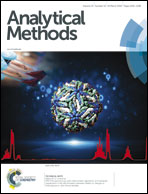The design strategies and mechanisms of fluorogenic and chromogenic probes for the detection of hydrazine†
Abstract
The high toxicity of hydrazine to human health in combination with its impact on the environment warrants the development of sensitive methods for the detection of hydrazine. Among various methods for detecting hydrazine, colorimetric and fluorimetric sensors grabbed special attention of the scientific community due to their sensitive nature and biological compatibility. Selective recognition of hydrazine is always more challenging in comparison with the recognition of metal ions owing to the limited modes of reaction and strong hydrogen bonding of hydrazine with many of the solvents. This review highlights the representative cases with a succinct overview of the developments in optical sensing strategies of hydrazine from a structural and mechanistic point of view with an emphasis on the features of the recognition sites and modes of action that make these probes efficient for the detection. In addition, comparative data of all the probes have been discussed along with the current challenges later in this review.

- This article is part of the themed collections: Recent Review Articles and Analytical Methods 2018 Most Downloaded Articles


 Please wait while we load your content...
Please wait while we load your content...